The Bow and Arrow Choke
By: Daniel Frank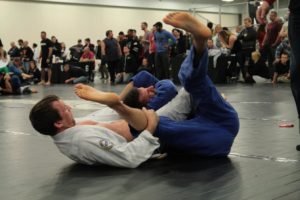
If you enjoy watching high level Brazilian jiu jitsu black belt matches, then you know that submission finishes are hard to come by. One submission that regularly ends those matches, and stands out from the rest, is the bow and arrow choke. There are many precise details that go into a perfectly executed bow and arrow choke. Many of those details vary when taught at one academy or another. Those details may vary from instructor to instructor. In this article, I have gathered various details from instructors, on three different continents, in order to provide you with a pathway to this devastating finish.
The bow and arrow choke is a very technical choke in that you cannot move straight to the choke. It takes some time to set up a quality bow and arrow choke and there are a few different set ups that lead to success. The choke is easiest when set up while positioned on your opponent’s back. However, your opponent’s defenses are more easily bypassed when you set up the choke in transition when the opponent moves to the turtle position or attempts to escape from under a solid position such as side control, knee-on-belly, or mount. I have found that a majority of bow and arrow chokes that I get, in competition, have come while my opponent is attempting to move. Whether the choke is set up in transition, or from a more stable position, finishing grips and positions remain true and the instructors in this article have different details to aide in this submission. We will address these details in an order 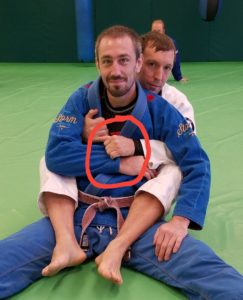 starting from position, to grips, and finally submission.
starting from position, to grips, and finally submission.
Anna Kavoura, a brown belt from Jyvaskylan Fight Club in Finland, emphasizes controlling position first. Anna begins her back position with both of her arms under her opponent’s arms controlling the opponent’s lapels. While maintaining this great control she lets go of one lapel and reaches across the opponent’s chest to control the opponent’s far sleeve. By doing this Anna maintains control of the back and frees a hand to reach over the shoulder and begin her choke.
Josh Ross Ketry, black belt owner of Buffalo United Martial Arts in Buffalo, NY, emphasizes grips in order to have an effective bow and arrow choke. Josh stresses that, “controlling hip mobility is the job of your free hand”. Josh emphasizes three different grips, “Each one is better than the last.” The first grip is made to control the pants, near the hip. This grip is good for control, but does not give you a lot of leverage. Josh says that, “you can always improve your grips while applying the choke.” You can move from the first grip to the second where your hand slides down the seam of the pants and makes a grip at the knee. This grip allows control and leverage. The final grip Josh describes is switching the grip near the knee to fully underhooking the leg. This grip maximizes leverage and completes an effective attack.
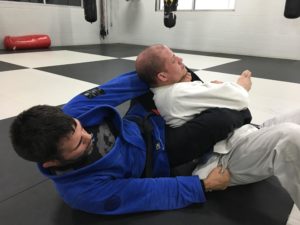 |
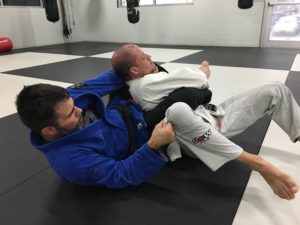 |
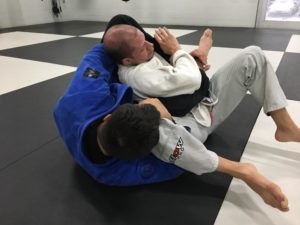 |
Lee Hyung Keun, a black belt from Korea BJJ Academy in South Korea, emphasizes theJ-grip made on the pants, near the knee, to control your opponent while finishing the choke. Instead of pulling, to create tension, he suggests maintaining a grip to follow the opponent’s movement without letting go in order to maintain control. Hyung Keun also suggests using your leg to drape over your opponent’s far arm to prevent them from grabbing your elbow and escaping the choke. This detail has probably been shared with you by many instructors. However, Hyung Keun suggests using your leg that is draped over the body as reinforcement to be placed over the first leg and guarantee the choke.
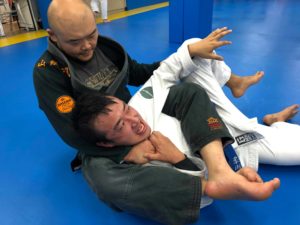
Seymour Yang, aka Meerkatsu, a black belt and head instructor at Borehamwood BJJ Club in England, stresses two points once the back position has been attained and your grips have been placed. The first point that Seymour makes is to hide the elbow of your choking arm. If you flare that elbow out, and expose it, your opponent may take the opportunity to lift the choke and to escape. The second point that he suggests is to push with your legs once the choke is locked into place. Seymour comments that the hand has already done its job and needs to pull slightly to choke. By using your strong legs to push the opponent’s body away you provide adequate leverage for a finish.
Finally, C.J. Murdock, a black belt from Top Martial Arts in North Carolina, provides slightly different details on the finish. Once he has secured his grips and has moved to the choking position C.J. explains that, “I try to finish with my bicep touching his hamstring and pull my elbows back and push my chest forward.”
Despite looking like a very straight forward jiu jitsu technique, the bow and arrow choke has many details to master. Once mastered the choke is overwhelming and finishes a match in convincing fashion. Follow one of these instructors’ details, or all of them, and hopefully this technique will find its way into your arsenal.